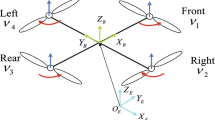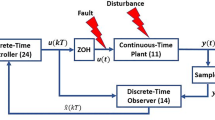Abstract
Handling both intermittent actuator faults and coupled interconnections in uncertain multiple-input–multiple-output nonlinear system is still a challenge in the control community. In this paper, to address this issue, an adaptive neural fault-tolerant control scheme is developed. Firstly, neural networks with random hidden nodes are used to approximate unknown functions, and an inequality is introduced to construct controllers such that the singularity problem of the controllers can be circumvented. Secondly, a projection algorithm is adopted to update online the estimated parameters in the controllers such that the boundedness of estimated parameters is ensured. In particular, the boundedness of estimate of unknown fault parameters with intermittent jumps can be definitely guaranteed. Due to the effects of intermittency jumps of unknown parameters on the system stability during operation, a modified Lyapunov function is developed to prove the system stability. It is proved that the system stability only depends on the jumping amplitude of Lyapunov function and the minimum fault time interval and is not affected by the total number of faults. Thirdly, a root mean square type of bound for the tracking error is established by using iterative calculation to illustrate that the system transient performance in the sense of the tracking error is adjustable by proper choice of design parameters. Finally, simulation studies are carried out to verify the effectiveness of the theoretical results.







Similar content being viewed by others
References
Krstic M, Kanellakopoulos I, Kokotovic PV (1995) Nonlinear and adaptive control design. Wiley, New York
Jain S, Khorrami F (1997) Decentralized adaptive output feedback design for large-scale nonlinear systems. IEEE Trans Autom Control 42(5):729–735
Wen C, Zhou J (2007) Decentralized adaptive stabilization in the presence of unknown backlash-like hysteresis. Automatica 43:426–440
Chen B, Lin C, Liu X, Liu K (2015) Adaptive fuzzy tracking control for a class of MIMO nonlinear systems in nonstrict-feedback form. IEEE Trans Cybern 45(12):2744–2755
Mehraeen S, Jagannathan S, Crow ML (2011) Decentralized dynamic surface control of large-scale interconnected systems in strict-feedback form using neural networks with asymptotic stabilization. IEEE Trans Neural Netw 22(11):1709–1722
Hamdy M, El-Ghazaly G (2014) Adaptive neural decentralized control for strict feedback nonlinear interconnected systems via backstepping. Neural Comput Appl 24(2):259–269
Tao G, Joshi SM, Ma X (2001) Adaptive state feedback and tracking control of systems with actuator failures. IEEE Trans Autom Control 46(1):78–95
Bodson M, Groszkiewicz JE (1997) Multivariable adaptive algorithms for reconfigurable flight control. IEEE Trans Control Syst Technol 5(2):217–229
Yang GH, Ye D (2010) Reliable \(H_{\infty }\) control of linear systems with adaptive mechanism. IEEE Trans Autom Control 55(1):242–247
Tang X, Tao G, Joshi SM (2003) Adaptive actuator failure compensation for parametric strict feedback systems and an aircraft application. Automatica 39:1975–1982
Tang X, Tao G, Joshi SM (2007) Adaptive actuator failure compensation for nonlinear MIMO systems with an aircraft control application. Automatica 43:1869–1883
Wang W, Wen C (2010) Adaptive actuator failure compensation control of uncertain nonlinear systems with guaranteed transient performance. Automatica 46:2082–2091
Wang W, Wen C (2011) Adaptive compensation for infinite number of actuator failures or faults. Automatica 47:2197–2210
Cai J, Wen C, Su H, Liu Z (2013) Robust adaptive failure compensation of hysteretic actuators for a class of uncertain nonlinear systems. IEEE Trans Autom Control 58(9):2388–2394
Lai G, Wen C, Liu Z, Zhang Y, Chen CP, Xie S (2018) Adaptive compensation for infinite number of actuator failures based on tuning function approach. Automatica 87:365–374
Wang C, Wen C, Guo L (2016) Decentralized output-feedback adaptive control for a class of interconnected nonlinear systems with unknown actuator failures. Automatica 71:187–196
Yang Q, Ge SS, Sun Y (2015) Adaptive actuator fault tolerant control for uncertain nonlinear systems with multiple actuators. Automatica 60:92–99
Shen Q, Jiang B, Shi P, Lim CC (2014) Novel neural networks-based fault tolerant control scheme with fault alarm. IEEE Trans Cybern 44(11):2190–2201
Shen Q, Jiang B, Cocquempot V (2014) Adaptive fuzzy observer-based active fault-tolerant dynamic surface control for a class of nonlinear systems with actuator faults. IEEE Trans Fuzzy Syst 22(2):338–349
Liu X, Wang YW, Chen D, Chen H (2016) Adaptive fuzzy fault-tolerant control for a class of unknown non-linear dynamical systems. IET Control Theory Appl 10(18):2357–2369
Li YX, Yang GH (2017) Adaptive fuzzy decentralized control for a class of large-scale nonlinear systems with actuator faults and unknown dead zones. IEEE Trans Syst Man Cybern Syst 47(5):729–740
Tong S, Huo B, Li Y (2014) Observer-based adaptive decentralized fuzzy fault-tolerant control of nonlinear large-scale systems with actuator failures. IEEE Trans Fuzzy Syst 22(1):1–15
Li Y, Tong S (2017) Adaptive neural networks decentralized FTC design for nonstrict-feedback nonlinear interconnected large-scale systems against actuator faults. IEEE Trans Neural Netw Learn Syst 28(11):2541–2554
Semprun KA, Yan L, Butt WA, Chen PC (2017) Dynamic surface control for a class of nonlinear feedback linearizable systems with actuator failures. IEEE Trans Neural Netw Learn Syst 28(9):2209–2214
Li XJ, Yang GH (2018) Neural-network-based adaptive decentralized fault-tolerant control for a class of interconnected nonlinear systems. IEEE Trans Neural Netw Learn Syst 29(1):144–155
Zhang TP, Ge SS (2008) Adaptive dynamic surface control of nonlinear systems with unknown dead zone in pure feedback form. Automatica 44:1895–1903
Huang GB, Zhu QY, Siew CK (2006) Extreme learning machine theory and applications. Neurocomputing 70:489–501
Huang GB, Chen L, Siew CK (2006) Universal approximation using incremental constructive feedforward networks with random hidden nodes. IEEE Trans Neural Netw 17(4):879–892
Huang GB, Zhou H, Ding X, Zhang R (2012) Extreme learning machine for regression and multiclass classification. IEEE Trans Syst Man Cybern B Cybern 42(2):513–529
Liu X, Jutan A, Rohani S (2004) Almost disturbance decoupling of MIMO nonlinear systems and application to chemical processes. Automatica 40:465–471
Acknowledgements
This work is supported in part by the National Natural Science Foundation of China under Grant 61633001, 61673315, 61075001.
Author information
Authors and Affiliations
Corresponding author
Additional information
Publisher's Note
Springer Nature remains neutral with regard to jurisdictional claims in published maps and institutional affiliations.
Appendix
Appendix
1.1 Proof of Lemma 2
Proof
Integrating both sides of (31) over \([t_{i}^{q_i},t_{i}^{q_i+1})\) and using \(V_{i}(t_{i}^{(q_i+1)-})=V_{i}(t_{i}^{(q_i+1)+})-\Delta {V}_{i}^{q_i}\) obtained from (32), we have
We suppose that \(N_i(0,T)\) denotes the total number of actuator faults for the \(i\hbox {th}\) subsystem during [0, T). Then, according to (49), in the intervals \(\left[ 0,t_{i}^{1+}\right] ,\ldots ,\left[ t_{i}^{\left( N_i(0,T)-1\right) +},t_{i}^{(N_i(0,T))+}\right]\), the following inequalities hold:
Considering (50) and (51), in the time interval [0, T), we have
According to [15], we can easily obtain \(N_i(t_{i}^{q_i},T)\le (T-t_{i}^{q_i})/T_i^*\) where \(T_i^*\) is defined in (34), which implies that \(t_{i}^{q_i}-T\le -N_i(t_{i}^{q_i},T)T_i^*\). Thus, the term \(\sum _{q=1}^{N_i(0,T)}{\mathrm{e}}^{\chi _{i}(t_{i}^{q_i}-T)}\le (1-{\mathrm{e}}^{-\chi _{i}T_i^*N_i(0,T)})/(1-{\mathrm{e}}^{-\chi _{i}T_i^*})\). Using the fact \(N_i(0,T)\le {T}/T_i^*\) and \(|\Delta {V}_{i}^{q_i}|\le \zeta _i\) from (33), (52) satisfies
Using the fact that \(\lim _{T\rightarrow \infty }(1-{\mathrm{e}}^{-\chi _{i}T})=1\), the inequality (34) can be obtained. \(\square\)
1.2 Proof of Theorem 2
Proof
Revisiting (31), the time derivative of \(V_i\) can also satisfy
where \(\delta _{i}\) is given in (31), \(c_i=\min _{j_i=1,\ldots ,n_i}\{c_{i,j_i}\}\), \(z_i=[z_{i,1},\ldots ,z_{i,n_i}]^{\mathrm {T}}\).
Integrating both sides of (54) over \([t_{i}^{q_i},t_{i}^{q_i+1})\), we can obtain the following iteration formula by using \(V_{i}(t_{i}^{(q_i+1)-})=V_{i}(t_{i}^{(q_i+1)+})-\Delta {V}_{i}^{q_i}\) obtained from (32)
For an arbitrary time instant \(T>0\), \(N_i(0,T)\) denotes the total number of actuator faults for \(i\hbox {th}\) subsystem during [0, T). So, using iteration formula (55), in the intervals \(\left[ 0,t_{i}^{1+}\right] ,\ldots ,\left[ t_{i}^{(N_i(0,T)-1)+},t_{i}^{N_i(0,T)+}\right]\), we have
From (56), (57) and \(|\Delta {V}_{i}^{q_i}|\le \zeta _i\), \(q_i=1,\ldots ,N_i(0,T)\), obtained from (33), in the time interval [0, T), we have
On the other hand, from (53), we have
where we have used the fact that \((1-{\mathrm{e}}^{-\chi _{i}T})/T\le \chi _{i}\) and \(\lim _{T\rightarrow \infty }{\zeta _i}/({T(1-{\mathrm{e}}^{-\chi _{i}T_i^*})})=0\). By substituting (59) into (58) and using the fact \(\chi _{i}/c_i\le 2\), we have
For the whole system, considering (60), we obtain
where \(c_0=\min _{i=1,\ldots ,N}\{c_i\}\). \(V(0)=\sum _{i=1}^NV_{i}(0)\) and
By using trajectory initialization technique [1, 3], we can set \(z_{i,j_i}(0)\) to zero, i.e., let \(z_{i,1}(0)=y_{\mathrm {d}i}(0)\), \(z_{i,j_i}(0)=\alpha _{i,j_i-1}(0)\). Then using the fact \(N_i(0,T)T_i^*\le {T}\) and substituting (62) and \(\delta _{i}\) into (61), the bound (36) is established. \(\square\)
Rights and permissions
About this article
Cite this article
Nai, YQ., Yang, QY. & Zhang, ZQ. Adaptive neural fault-tolerant control for uncertain MIMO nonlinear systems with actuator faults and coupled interconnections. Neural Comput & Applic 32, 12755–12770 (2020). https://doi.org/10.1007/s00521-020-04723-y
Received:
Accepted:
Published:
Issue Date:
DOI: https://doi.org/10.1007/s00521-020-04723-y




